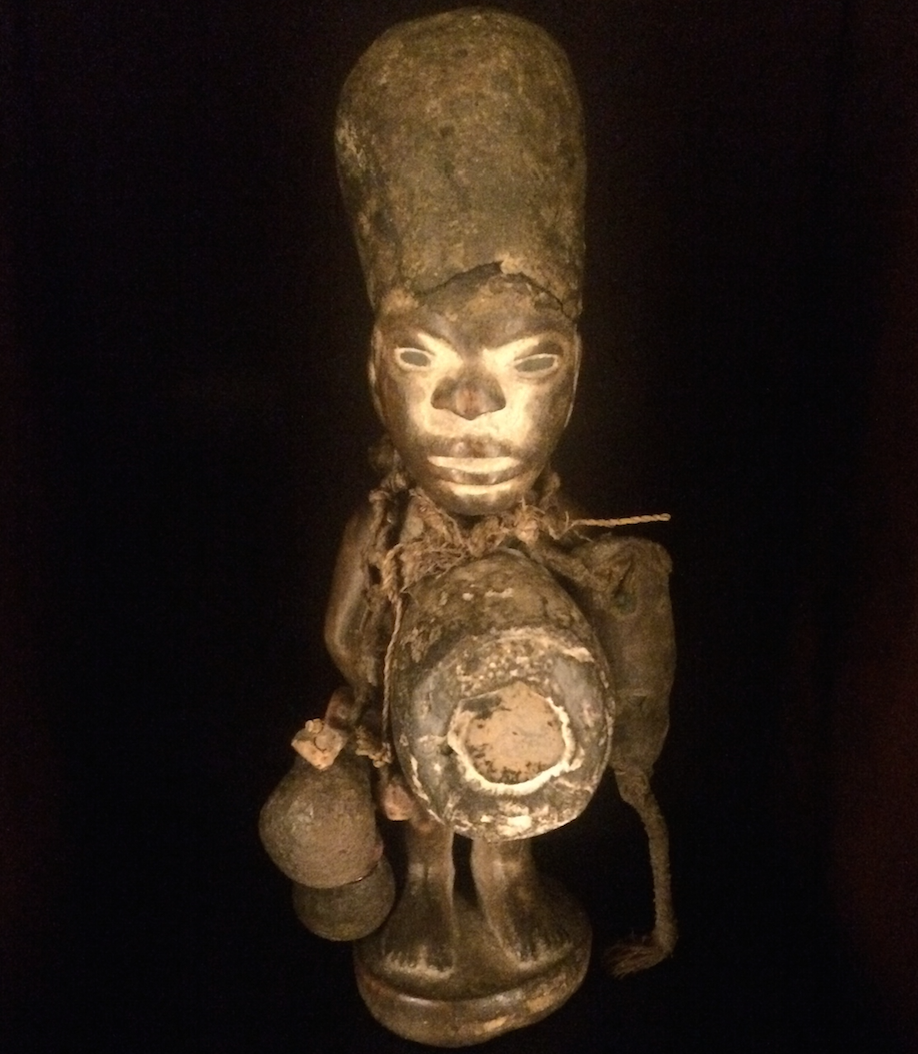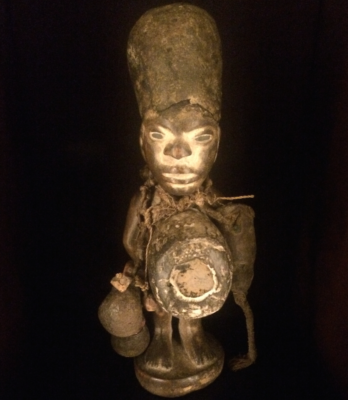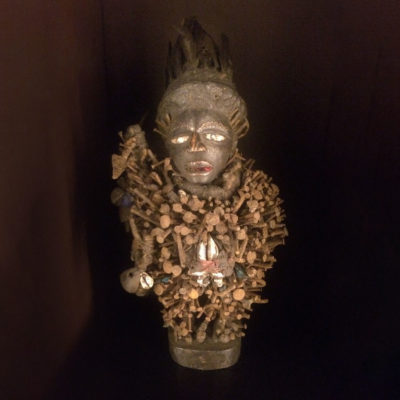The travesty of George Floyd’s murder, and the relentless replay of it, tore the top off the blister of 400 years of racism festering in our country. In the weeks following, like many white people, I read books, watched films, and meditated. Each week I hoped to post an essay, but had no words.
When I visited the Quai Branly Museum in Paris a few years ago the vast anthropological collection inspired me. I photographed a series of totems from Africa as sources of wonder, worthy of deep consideration. And now they returned in dreams, in meditation, when hiking in the woods. Persistent…haunting. What could they tell me? What did they want?
After weeks of research about our society today, I researched the history of these artifacts, to trace why this golden bronze face, pictured below, was coming to mind every time I tried to write about race.
Centuries have not diminished the illuminating glow emanating from this tiny statue, one of many originally crafted to honor resources such as water, mountains, or harvest. The tenacity and worth captured by the posture and expression, these are riveting, powerful and memorable. This figure was crafted five centuries ago in the Kingdom of Kongo on the east coast of Africa. (The name comes from the KiKongo language spoken there).
From the 1390’s the Kingdom had a government ruled by elected officials. Kongo people practiced a dualistic religion, based on life as it is seen through daily interaction, and the unseen–influenced by spirits of the dead and supernatural. There is no written history of the early Kingdom. Later accounts by Europeans reflect bias and are therefore not fully reliable.
In the late1400’s the Portuguese first traveled to the Kongo region, seeking a waterway to India. Welcomed by the King of Kongo, the Portuguese established themselves on a small island and began trading for copper and ivory. But within a decade, these new neighbors demanded labor instead of goods, and in an escalating and seemingly inescapable pattern, developed what would become the nexus of the slave trade. An accurate account of the evolution and vicissitudes of the slave trade in Africa can be read here: https://www.sahistory.org.za/article/kingdom-kongo-1390-1914.
From1570-1867 it is calculated that 5.69 million Africans were captured, transported and embarked from the Kongo coast to serve the labor needs of the Americas as well as various small islands later named Haiti, the Bahamas, Cuba and etc. During this period priests, officials, slave traders and slave owners persistently sought to dehumanize the African race as a means to justify the slavery practice. This disinformation about the peoples of Africa spread fear and judgment, embedding seeds of racism throughout Europe and the Americas.
The African culture of Kongo changed radically. Elections ceased. Descendants of the king now ruled, and these kings were known to trade in Africans captured from other regions. The seen and the unseen dualistic Kingdom religion transformed to a blended form of Christianity. A typical Kongo icon from the late 1800’s is shown above, with nails piercing nearly every surface. Unceasing pain seems to be the message from this period, piercing the very worth, the power, the knowingness once so vivid in the glowing artifact from 300 years before.
This May the relentless replay of the murder of George Floyd drove nails straight into the denial, the numbness, and the avoidance of racism in our country. Racial disrespect, pretension, fear, grief, guilt, despair, and shame are like the nails piercing the second Kongo effigy. Nails which only we, in America, can extract, using care, awareness, and respect.
What can these totems tell us today? What are they seeking?
When I was twelve six simple words motivated me to change my life. This awakening, this sudden schooling, came from the words of a poster designed by an artist and anti war activist, Sister Mary Corita:
“I greet the light within you.”
When I saw this simple phrase in 1962 I immediately felt a possibility, a presence of respect. This changed how I saw my world and my place in it. I realized the life I was living was not authentic, and not likely to deepen, unless I left home. Authenticity did not happen that day; that work is ongoing. But without awakening there is no beginning…
Fifty years later, the gleaming icon captured in the Quai Branly radiates this message to us, like a drum beat from the heart. Awaken. See what has previously been unseen. Greet the light, name the gifts, honor the value therein. True equity is an unexplored territory, full of challenge and treasure.
When I designed this blog I chose the nailed icon to represent my idea of “How to be Human.” In my naïve, uneducated view the nails represented womanly inequality, loss, and struggle. And now, schooled on where these artworks actually came from, I see two things—the seen world, where I appropriated the suffering from another culture, and the unseen world, where these supernatural totems insisted I widen my lens. May they spirit you along your path to acceptance, forgiveness, tolerance and love. Be the compassionate witness. Bear it. Stand up. Greet the light and widen your lens.
In preparing this post I consulted many sources and discussed perspectives with family, friends and authorities. Listed below are some I found helpful:
White Fragility by Robin Diangelo
How to Be an Anti-Racist by Ibram X. Kendi
I’m Still Here, Dignity in a World Made for Whiteness by Austin Channing Brown
The Souls of Black Folk W.E.B. Du Bois
Just Mercy by Bryan Stevenson
8 Can’t Wait https://8cantwait.org
NAACP www.naacp.org
Tara Brach https://www.youtube.com/watch?v=7MLGkGCLKw8&feature=emb_logo
Movies: Best of Enemies
13th Amendment
Just Mercy



How very beautifully written, Elisa… thought provoking, enlightening, humbling. I applaud your deep dive into a subject so many are uncertain of, have a fear of and a worry how to engage if at all … am grateful for your sharing. You reminded me of the simplicity of Sister Mary Corita so far ago in our lives… her words resonate more clearly than ever. Thank you for that reminder. xo S
You opened a new world to
me. How deeply you researched and broadened my perspective. Excellent work from you- as usual.
Love you,
Phyllis
Brilliant and enlightening! Thanks Elisa.
Elisa..this is so thought provoking. Man’s inhumanity against man has been around since the beginning of time. Hopefully in todays global world and viral videos it will be seen and stopped. We are all evolving. I love the statue with the nails..his expression is timely. Very well written and insightful article. With love, Susan K
Beautiful, thought deepening, well resourced and shared. I very much appreciate your work and perspective. Next step: how to activate?
So glad to have met you,
Mary
Elisa,
This is so interesting and timely, topped off by beautiful writing! I really enjoyed reading it and learning. I saw an exhibit of Sister Corita’s work at the Women’s Museum in Washington DC sometime this decade- do you know this museum? Worth a trip (if and when ). It was great to see a larger body of her work, only remembering the visuals from the 60s. You are always amazing and showing the light! Keep up this great blog. Isabel
What an inspiring commentary on your travels as well as finding new meaning in the art you photographed! Lovely writing as well. I have always been inspired by my first love, Anthropology. My childhood heroes were Jane Goodall and Margaret Mead. My mother was a great believer in collecting stacks upon stacks of National Geographic magazines. Ahhh, the 70’s! They inspired me to major in Anthro with my field study being Meso-American Pre-History and Culture. Recently, I was reminded that it was Margaret Mead who said years ago, anthropologist Margaret Mead when asked by a student what she considered to be the first sign of civilization in a culture. The student expected Mead to talk about fishhooks or clay pots or grinding stones. But no. Mead said that the first sign of civilization in an ancient culture was a femur (thighbone) that had been broken and then healed. Mead explained that in the animal kingdom, if you break your leg, you die. You cannot run from danger, get to the river for a drink or hunt for food. You are meat for prowling beasts. No animal survives a broken leg long enough for the bone to heal.”“A broken femur that has healed is evidence that someone has taken time to stay with the one who fell, has bound up the wound, has carried the person to safety and has tended the person through recovery. Helping someone else through difficulty is where civilization starts, Mead said.” I think about this often today as I contemplate an American society which places so little importance on healthcare or helping others. I wonder what Margaret would say about our country or ‘civilization’ today…….
We are living in an age of pain, fury, outrage at injustice, and feeling powerless we lash out at others – on the streets, on social media and in virtual public meetings. I’m trying to listen, learn, heal and encourage healing and restorative justice. Many are not ready for the lessons of history or for introspection to understand that lashing out at others is not working on finding the “light” within ourselves and others. Thank you, Elisa for your reflections.
Beautifully written! Thank you ❤️